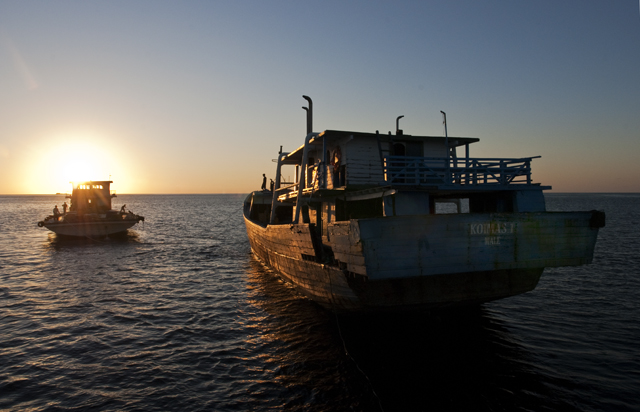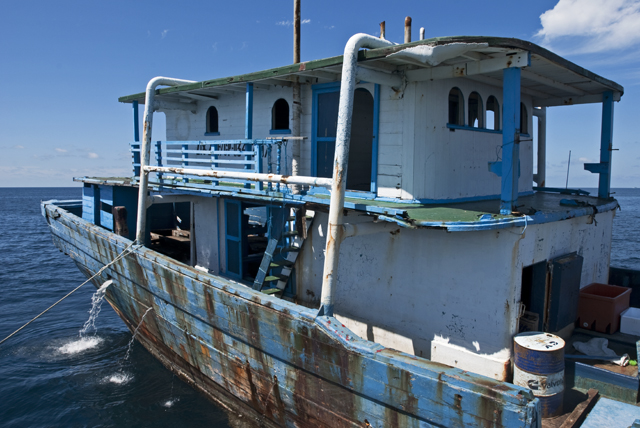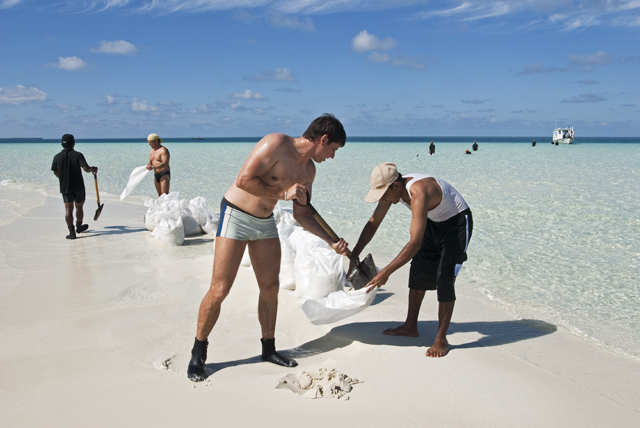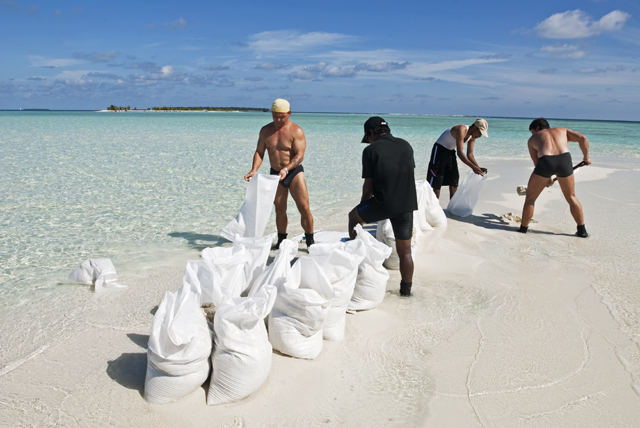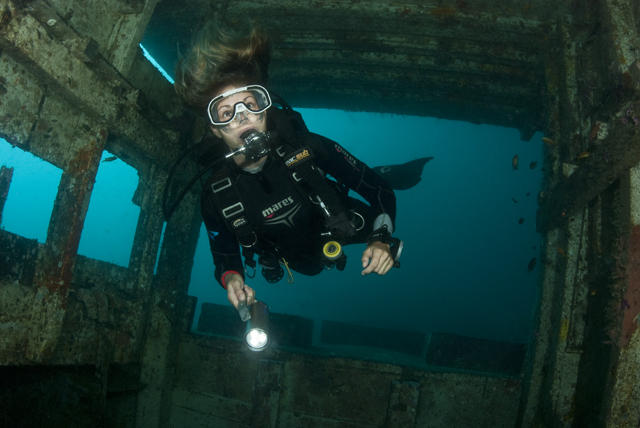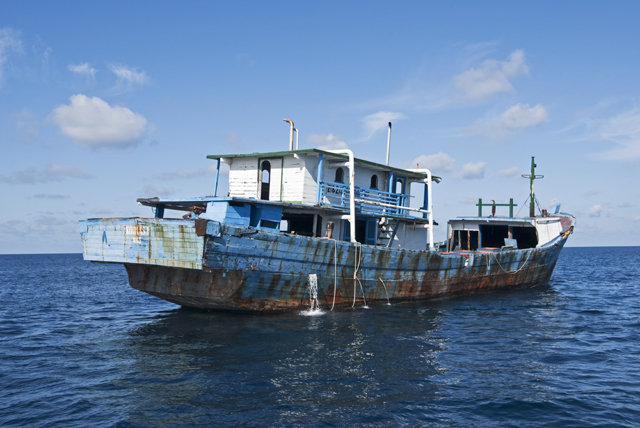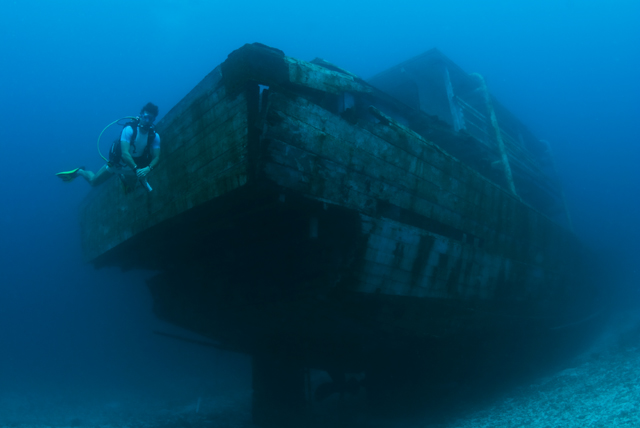News
We are sinking! (Or are we?)
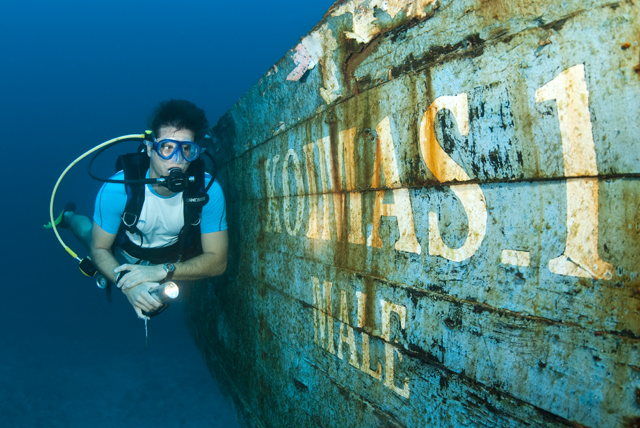
My exploits on Filitheyo in the Maldives reminded me of a funny story about the German Coastguard misinterpreting a mayday call. Fortunately there was no one actually ‘in distress’ throughout my escapade. I would probably say extremely frustrated was a better description. The other slight difference was the fact that our boat wouldn’t sink. Werner Lau dive centre had acquired the perfect fishing boat for a new artificial reef project. Unsettled weather had caused a few problems with the delivery dates but this was the ‘chilled out’ Maldives so nobody really minded.
The boat eventually appeared 2 weeks later so operation code named ‘we are thinking’ finally began. The task was to simply position the boat over the drop zone and sink it upright. Surely German ingenuity combined with hard working Maldivian labour could easily sort this task out? Well, think again. When does anything go as planned? In true Paparazzi style I witnessed the whole watery exclusive unfolding before me, warts and all…
Filitheyo Resort is the perfect apparition of paradise; a beautiful triangular shaped coral island complete with dreamy white sandy beaches and azure hued seas rich in marine life. There are 110 thatched roofed luxury Bungalows dotted amongst the swaying palms and a further 15 more located out on the water. Werner Lau set up the diving centre in 1999 coinciding with the opening of the resort. Regional Manager, Christian Machler, had handpicked an experienced crew to run the diving operation. They were a really friendly bunch and exuded plenty of positive vibes. In true Werner Lau style the daily boats always left on schedule. Any latecomers would be towel whipped and staked out in the sun as punishment!
The island offered some great shore diving opportunities. Werner Lau had marked the entry/exit points of every site with a numbered post that protruded out of the water in the sandy shallows. Underwater there were buoyed and anchored guide ropes placed vertically down the reef wall indicating where divers should get in or out (and also to hold on to in strong currents). On the beach, shaded under the palms, they had placed wooden benches for de-kitting. The benches were also used as drop-off points for any empty cylinders. Dive centre staff rounded up any empties during the day and took them back to the centre for refilling. The whole set-up had been well thought out and as expected ran extremely efficiently. As a further attraction Werner Lau had sunk a fishing boat, Koimas.2, on November 30th 2009. This was to be complimented with a second fishing boat, Koimas.1, just over a year later.
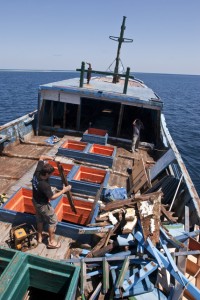
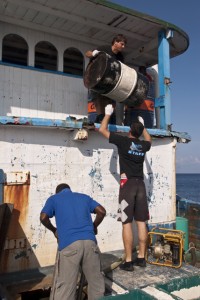 Christian had liaised with the Resort Management team and the 17th December 2010 (give or take a day for any contingencies) was set as the date of sinking. I turned up on the evening of the 16th just in time to witness the fishing boats arrival. At 23 metres long with a 6.5 metre beam the boat was bigger than I had expected. Christian had specifically asked the boatyard to ‘clean’ the boat before delivery. We hopped aboard for a quick look around and there was still rubbish all over the deck, loose rotting wood, protruding nails and even some diesel fuel left in the tanks. There was no way the boat could be sunk in this condition. I started to wonder whether my 7-day trip would be a fruitless exercise.
Christian had liaised with the Resort Management team and the 17th December 2010 (give or take a day for any contingencies) was set as the date of sinking. I turned up on the evening of the 16th just in time to witness the fishing boats arrival. At 23 metres long with a 6.5 metre beam the boat was bigger than I had expected. Christian had specifically asked the boatyard to ‘clean’ the boat before delivery. We hopped aboard for a quick look around and there was still rubbish all over the deck, loose rotting wood, protruding nails and even some diesel fuel left in the tanks. There was no way the boat could be sunk in this condition. I started to wonder whether my 7-day trip would be a fruitless exercise.
The idea was to follow the same game plan used for Koimas.2 just over a year ago. This meant positioning the boat at the designated drop zone (between marker posts 5 and 6), filling the boat with sand until the gunnels (sides) reached sea level and then pump in sea water until the boat finally sank. Being so heavy the boat should stay in an upright position and descend to the seabed in one piece. Christian was told that the boat had a gross tonnage of 89 tonnes. So we basically needed to shift around 89 tonnes of sand from the nearby sand bank and plonk it into the holds before adding any water. This meant there was still a lot of hard work left to do before the boat would be ready for sinking. My absolute deadline for any diving activities was the 20th December. Serious pangs of doubt began to creep into my mind.
Local labour and resort staff were supposed to be helping from the outset but only a handful turned up for work on the 17th December. It was mainly Werner Lau staff that ended up cleaning the fishing boat ready for sand bag loading. Two days were spent filling sand bags, transporting them to the fishing boat and dumping them inside the holds and engine compartment. Even I started to help out and believe me humping heavy bags of sand in the midday sun was no easy job.
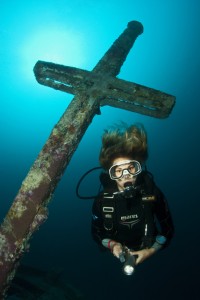
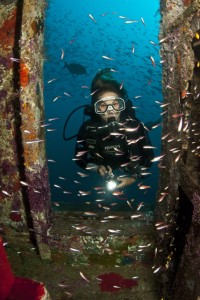 In between time I managed to take a good look around the first wreck, Koimas.2. Joint Base Leader, Astrid Poelzl, guided me around the 25 metre long fishing boat starting by the prop at 32 metres. I had to watch my positioning as there were a number of stingrays lying in the sand. A few inquisitive jacks cruised by as I took a picture of Astrid posing by the colourful blades. We finned along the hull towards the bow. The wreck was still fully intact and had become home for many species of reef fish. The crucifix shaped foredeck mast was definitely the most photogenic feature. We stopped momentarily when a shoal of around 10 devil rays passed overhead. I then followed Astrid through an open hatchway down into the cargo hold. The fishing boat only had a 2.2 metre draft so we didn’t have very far to descend. The hold interconnected with 2 more holds and came out next to the bridge. I had a quick look inside the engine compartment (without engine). This was just a huge wide open space completely open and accessible. Another shoal of jacks darted in and out of the gaps between the wooden panelling. I managed to jam myself inside the small bridge area to get a shot of Astrid looking through the doorway at a small shoal of resident glassfish. This looked quite effective against the deep blue backdrop. I had noticed the current picking up throughout the dive. After 40 minutes the rate had increased to around 3 or 4 knots and was impossible for me to swim against. Astrid started power finning for exit point no.5 but with a camera in hand and being a chubby unfit diver I much preferred to take the easy option and drift back to exit no.6 even if it did mean a longer walk back to the dive centre.
In between time I managed to take a good look around the first wreck, Koimas.2. Joint Base Leader, Astrid Poelzl, guided me around the 25 metre long fishing boat starting by the prop at 32 metres. I had to watch my positioning as there were a number of stingrays lying in the sand. A few inquisitive jacks cruised by as I took a picture of Astrid posing by the colourful blades. We finned along the hull towards the bow. The wreck was still fully intact and had become home for many species of reef fish. The crucifix shaped foredeck mast was definitely the most photogenic feature. We stopped momentarily when a shoal of around 10 devil rays passed overhead. I then followed Astrid through an open hatchway down into the cargo hold. The fishing boat only had a 2.2 metre draft so we didn’t have very far to descend. The hold interconnected with 2 more holds and came out next to the bridge. I had a quick look inside the engine compartment (without engine). This was just a huge wide open space completely open and accessible. Another shoal of jacks darted in and out of the gaps between the wooden panelling. I managed to jam myself inside the small bridge area to get a shot of Astrid looking through the doorway at a small shoal of resident glassfish. This looked quite effective against the deep blue backdrop. I had noticed the current picking up throughout the dive. After 40 minutes the rate had increased to around 3 or 4 knots and was impossible for me to swim against. Astrid started power finning for exit point no.5 but with a camera in hand and being a chubby unfit diver I much preferred to take the easy option and drift back to exit no.6 even if it did mean a longer walk back to the dive centre.
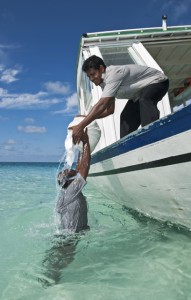
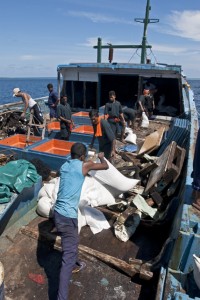 Getting back to the sinking of Koimas.1 we finally mustered full mobilisation on the 20th December. Locals and resort staff turned up in force but in my mind this was 3 days too late. The locals collected 4 boat loads of sand (200 bags per load) and the resort staff also managed to collect 4 boat loads (150 bags per load). The bags were brought alongside and then emptied into the bow holds and into the engine compartment amidships. Christian estimated that each bag weighed approximately 30kg which meant there were 1,400 bags totalling 42,000 kg’s of sand dumped onto Koimas.1. But the boat still wouldn’t sink. Even though there was a slight list to starboard and a small leak in the engine room she was still bobbing away quite nicely above the waterline. We had humped and sweated more than 80 tonnes of sand and cement onto the damn boat.
Getting back to the sinking of Koimas.1 we finally mustered full mobilisation on the 20th December. Locals and resort staff turned up in force but in my mind this was 3 days too late. The locals collected 4 boat loads of sand (200 bags per load) and the resort staff also managed to collect 4 boat loads (150 bags per load). The bags were brought alongside and then emptied into the bow holds and into the engine compartment amidships. Christian estimated that each bag weighed approximately 30kg which meant there were 1,400 bags totalling 42,000 kg’s of sand dumped onto Koimas.1. But the boat still wouldn’t sink. Even though there was a slight list to starboard and a small leak in the engine room she was still bobbing away quite nicely above the waterline. We had humped and sweated more than 80 tonnes of sand and cement onto the damn boat.
Werner Lau paid the resort $20,000 USD for Koimas.1. This fee also accounted for the cleaning and sinking of the vessel in the agreed timescale. But the whole situation had got quite frustrating. Whether it was down to politics, mis-communication or dare I say bad management we would surely miss my deadline. Christian advised that they should start pumping in water but frustratingly ‘the powers that be’ insisted we first pile on another load of sand bags.
My last diving day had come and gone and still the boat was defiantly floating. On the 21st when I left for home the locals added another 1,400 bags so the total weight of sand was now up to 84,000 kg’s. Resort staff had also made other preparations including drilling holes in all the decking to release any air trapped below and tying 12 empty oil drums around the bridge supports to help stabilize the boat and keep it upright on the way down.
Ironically the boat sank at 7-15pm on the 23rd of December in the dark with only a few people watching and without any pictures being taken. Werner Lau Divemaster, Ibi Didi, was conducting a night dive at the time. Even though he was just 100 metres away he didn’t hear any unusual noises underwater. On surfacing he was surprised to find that Koimas.1 had disappeared beneath the waves. A guest sitting on the beach said that the boat sunk engine room first and then the bow. From start to finish the whole performance had taken less than a minute. Over the new-year celebrations Werner Lau invited guests on a complimentary clean-up dive. More than 14 guests and 3 staff collected 100kg of loose wood, fibre glass, plastic etc lying around the wreck site.
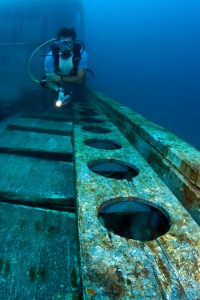
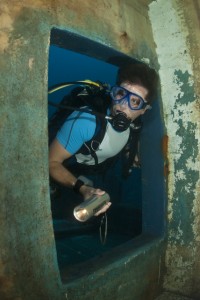 I decided to go back to the island 2 weeks later too finish the job I had started. Christian explained that when he dived on the new wreck for the very first time all was not as expected. First the good news: the boat had landed on the bottom upright and was lying in the correct position. Then the bad news: no one had time to slacken off the 8 mooring lines that were holding the boat in position. The lines had pulled so tight that they had ripped the bow apart and toppled the foredeck mast. In some ways this gave the wreck more character and it looked more like a real ship wreck and not just an artificial reef. I managed to wriggle in through the gap at the bow and take a picture of Christian surrounded by the refrigeration pipes once used for freezing the fish stored in the holds. A sizeable Moray hovered above my head during the whole escapade, probably wondering what all the fuss was about. The prop was the deepest point at 34 metres. I fired off a few shots of Chris next to a massive parrot fish nibbling on the steelwork, which I’m sure couldn’t have been very tasty. It was a strange feeling to ‘fly’ around the boat and not worry about climbing stairwells or ladders to get from one level to another. Just by breathing out I could drop down into the engine compartment. 2 weeks earlier I had been throwing sand bags into this huge void. I noticed that the oil drums had been removed from the bridge area. Christian said that they had imploded on the way down and when they were untied and sent back to the surface they had expanded back to their original shape.
I decided to go back to the island 2 weeks later too finish the job I had started. Christian explained that when he dived on the new wreck for the very first time all was not as expected. First the good news: the boat had landed on the bottom upright and was lying in the correct position. Then the bad news: no one had time to slacken off the 8 mooring lines that were holding the boat in position. The lines had pulled so tight that they had ripped the bow apart and toppled the foredeck mast. In some ways this gave the wreck more character and it looked more like a real ship wreck and not just an artificial reef. I managed to wriggle in through the gap at the bow and take a picture of Christian surrounded by the refrigeration pipes once used for freezing the fish stored in the holds. A sizeable Moray hovered above my head during the whole escapade, probably wondering what all the fuss was about. The prop was the deepest point at 34 metres. I fired off a few shots of Chris next to a massive parrot fish nibbling on the steelwork, which I’m sure couldn’t have been very tasty. It was a strange feeling to ‘fly’ around the boat and not worry about climbing stairwells or ladders to get from one level to another. Just by breathing out I could drop down into the engine compartment. 2 weeks earlier I had been throwing sand bags into this huge void. I noticed that the oil drums had been removed from the bridge area. Christian said that they had imploded on the way down and when they were untied and sent back to the surface they had expanded back to their original shape.
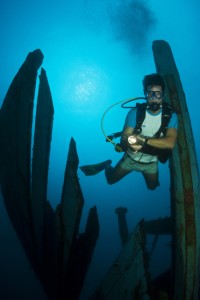
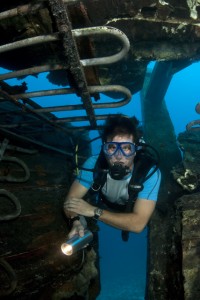 So operation ‘we are thinking’ had ended up as a complete success. The fishing boat eventually went down in the right spot without too much damage. The job just took a little longer than anticipated. I really enjoyed diving on both wrecks and I’m sure that Koimas.1 will be a big attraction for divers. The new wreck sits just 50 metres away from Koimas.2 and they are actually facing bow to bow. Due to the depth (and the currents) I would recommend exploring the wrecks on separate dives rather than try and rush around both wrecks on a single dive.
So operation ‘we are thinking’ had ended up as a complete success. The fishing boat eventually went down in the right spot without too much damage. The job just took a little longer than anticipated. I really enjoyed diving on both wrecks and I’m sure that Koimas.1 will be a big attraction for divers. The new wreck sits just 50 metres away from Koimas.2 and they are actually facing bow to bow. Due to the depth (and the currents) I would recommend exploring the wrecks on separate dives rather than try and rush around both wrecks on a single dive.
I was pleased to see that this battered old fishing boat had been used in such a positive way. What was once a floating wooden hulk had now been transformed into an underwater haven perfect for fish and corals. I had well and truly left my mark on Koimas.1 and would always have a bond with the wreck. I even broke a finger nail emptying out sand bags! I am really looking forward to going back in a few years time just to see how much the wreck has flourished.
Blogs
Northern Red Sea Reefs and Wrecks Trip Report, Part 2: Wall to Wall Wrecks

Jake Davies boards Ghazala Explorer for an unforgettable Red Sea diving experience…
The second day’s diving was a day full of wreck diving at Abu Nuhas, which included the Chrisoula K, Carnatic, and Ghiannis D. The first dive of the day was onto the Chrisoula K, also known as the wreck of tiles. The 98m vessel remains largely intact where she was loaded with tiles which can be seen throughout the hold. The stern sits at 26m and the bow just below the surface. One of the highlights of the wreck is heading inside and seeing the workroom where the machinery used for cutting the tiles are perfectly intact. The bow provided some relaxing scenery as the bright sunlight highlighted the colours of the soft coral reef and the many reef fish.

Following breakfast, we then headed to the next wreck, which was the Carnatic. The Carnatic is an 89.9m sail steamer vessel that was built in Britain back in 1862. She ran aground on the reef back in 1869 and remains at 27m. At the time, she was carrying a range of items, including 40,000 sterling in gold. An impressive wreck where much of the superstructure remains, and the two large masts lay on the seafloor. The wooden ribs of the hull provide structures for lots of soft corals, and into the stern section, the light beams through, bouncing off the large shoals of glass fish that can be found using the structure as shelter from the larger predators that are found outside of the wreck.

The final wreck at Abu Nuhas was the Ghiannis D, originally called ‘Shoyo Maru,’ which was 99.5m long and built in Japan back in 1969 before becoming a Greek-registered cargo ship in 1980. The ship then ran aground on the reef on April 19th, 1983, and now sits at the bottom at a depth of 27m. Heading down the line, the stern of the ship remains in good condition compared to the rest of the hull. The highlight of the wreck, though, is heading into the stern section and down the flights of stairs to enter the engine room, which remains in good condition and is definitely worth exploring. After exploring the interior section of the ship, we then headed over to see the rest of the superstructure, where it’s particularly interesting to see the large table corals that have grown at the bow relatively quickly considering the date the ship sank. After surfacing and enjoying some afternoon snacks, we made sure everything was strapped down and secured as we would be heading north and crossing the Gulf of Suez, where the winds were still creating plenty of chop.

The next morning, it was a short hop to Ras Mohammed Nature Reserve for the next couple of days of diving. The 6am wake-up call came along with the briefing for the first site we would be diving, which was Shark & Yolanda. The low current conditions allowed us to start the dive at Anemone City, where we would drift along the steep, coral-filled wall. These dives involved drifts, as mooring in Ras Mohammed wasn’t allowed to protect the reefs. As a dive site, Shark & Yolanda is well-known and historically had a lot of sharks, but unfortunately not so many in recent years, especially not so early in the season. However, there was always a chance when looking out into the blue.

The gentle drift took us along the steep walls of the site, with plenty of anemone fish to be seen and a huge variety of corals. It wasn’t long into the dive before we were accompanied by a hawksbill turtle, who drifted with us between the two atolls before parting ways. Between the two reefs, the shallow patch with parts of coral heads surrounded by sand provided the chance to see a few blue-spotted stingrays that were mainly resting underneath the corals and are always a pleasure to see. With this being the morning dive, the early sunlight lit up the walls, providing tranquil moments. Looking out into the blue, there was very little to be seen, but a small shoal of batfish shimmering underneath the sunlight was a moment to capture as we watched them swim by as they watched us.

Towards the end of the dive, we stopped at the wreck of the Jolanda where the seafloor was scattered with toilets from the containers it was carrying. This provided a unique site to make a safety stop, which was also accompanied by a large barracuda slowly swimming by, along with a hawksbill turtle calmly swimming over the reef as the sun rays danced in the distance.
For the next dive, we headed north to the Strait of Tiran to explore the reefs situated between Tiran Island and Sharm El Sheik, which were named after the British divers who had found them. We started on Jackson before heading to Gordons Reef, where we also did the night dive. All the atolls at these sites provided stunning, bustling coral reefs close to the surface and steep walls to swim along, which always provided the opportunity to keep an eye out for some of the larger species that can be seen in the blue. Midwater around Jackson Reef was filled with red-toothed triggerfish and shoals of banner fish, which at times were so dense that you couldn’t see into the blue. Moments went by peacefully as we enjoyed the slow drift above the reef, watching these shoals swim around under the mid-afternoon sun.

The night dive at Gordon’s Reef was mainly among the stacks of corals surrounded by sand, which was great to explore under the darkness. After some time circling the corals, we came across what we were really hoping to find, and that was an octopus hunting on the reef. We spent the majority of the dive just watching it crawl among the reef, blending into its changing surroundings through changes in colour and skin texture. It’s always so fascinating and captivating to watch these incredibly intelligent animals, in awe of their ability to carry out these physical changes to perfectly blend into the reef. Before we knew it, it was time to head back to the boat to enjoy a well-deserved tasty dinner prepared by the talented chefs onboard.
Check in for the 3rd and final part of this series from Jake tomorrow!
To find out more about the Northern Red Sea reef and wrecks itineraries aboard Ghazala Explorer, or to book, contact Scuba Travel now:
Email: dive@scubatravel.com
Tel: +44 (0)1483 411590
Photos: Jake Davies / Avalon.Red
Marine Life & Conservation
Double Bubble for Basking Sharks

 The Shark Trust is excited to announce that, for two more days only, all donations, large or small, will be doubled in the Big Give Green Match Fund!
The Shark Trust is excited to announce that, for two more days only, all donations, large or small, will be doubled in the Big Give Green Match Fund!
Donate to Basking in Nature: Sighting Giants
The Shark Trust is hoping to raise £10k which will be doubled to £20k. This will go towards Basking in Nature: Sighting Giants. And they need YOUR help to reach they’re goal.
The Shark Trust’s citizen science project is to monitor and assess basking sharks through sightings; encouraging data collection, community engagement, and promoting nature accessibility. This initiative aims to enhance health and wellbeing by fostering a deeper connection with British Sharks.
Campaign Aims
- Increase citizen science reporting of Basking Sharks and other shark sightings to help inform shark and ray conservation.
- Provide educational talks about the diverse range of sharks and rays in British waters and accessible identification guides!
- Create engaging and fun information panels on how to ID the amazing sharks and rays we have on our doorstep! These can be used on coastal paths around the Southwest. With activities and information on how you can make a difference for sharks and rays!
- Promote mental wellbeing through increasing time in nature and discovering the wonders beneath the waves!
Donate, and double your impact. Click Here
-

 News3 months ago
News3 months agoHone your underwater photography skills with Alphamarine Photography at Red Sea Diving Safari in March
-

 News3 months ago
News3 months agoCapturing Critters in Lembeh Underwater Photography Workshop 2024: Event Roundup
-

 Marine Life & Conservation Blogs2 months ago
Marine Life & Conservation Blogs2 months agoCreature Feature: Swell Sharks
-

 Blogs2 months ago
Blogs2 months agoMurex Resorts: Passport to Paradise!
-

 Blogs2 months ago
Blogs2 months agoDiver Discovering Whale Skeletons Beneath Ice Judged World’s Best Underwater Photograph
-

 Gear Reviews2 months ago
Gear Reviews2 months agoGear Review: Oceanic+ Dive Housing for iPhone
-

 Marine Life & Conservation2 months ago
Marine Life & Conservation2 months agoSave the Manatee Club launches brand new webcams at Silver Springs State Park, Florida
-

 News3 months ago
News3 months agoWorld’s Best Underwater Photographers Unveil Breathtaking Images at World Shootout 2023


